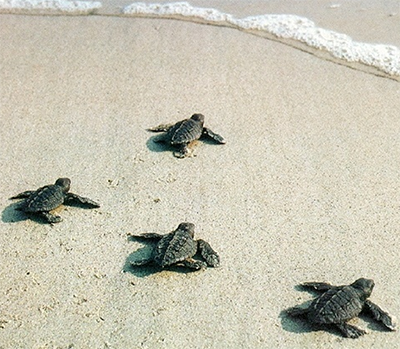NewsBank NewsLibrary NewsLibrary
Paper: Naples Daily News (FL) Title: Sand yields tiny turtles on area beaches Liz Ernst, Staff Writer
Date: July 17, 1996
The trail of tiny tracks leading from an abandoned nest was the only sign left at daybreak Monday of the first batch of turtle hatchlings on Bonita Beach this season. The liberation of some 121 baby loggerheads into the Gulf of Mexico on Sunday night marked the beginning of what could be the most successful turtle nesting season on Bonita Beach since the volunteers began monitoring the threatened creatures' nests seven years ago.

Turtles in Collier County are slightly ahead of their counterparts in Bonita, with the first hatch of the season occurring July 9 on Vanderbilt Beach and another Sunday near 33rd Avenue South in Naples. Experts in Naples say it will be too early to judge the success of the cycle until the bulk of the nests have hatched.
Sunday's nest in Naples was covered with fire ants when Conservancy workers noticed it had hatched and when they dug up the sand, 13 of the hatchlings were dead. Many others had already left the nest and 15 others were still punching their way out of the eggs.
To protect those from the ants, workers have taken the eggs to hatch in a bucket at the Conservancy until they can be released on the beach. Sea turtle nesting season - from May through October - begins with the female loggerhead leaving the water at night to dig her own nest and deposit between 100 and 125 eggs.
The task is considerable for the sea-dwelling mother, who weighs between 250 and 400 pounds and is not as mobile on land. She buries the incubating offspring before returning alone to the Gulf. If all goes well, roughly two months later the tiny turtles hatch and make a mad dash for the Gulf. Since development on and near the beach has taken on epic proportions, however, many of the hatchlings become disoriented by manmade light sources which attracts them away from the Gulf, making them vulnerable to predators and other environmental hazards.
This year, public education seems to have paid off. About 98 percent of beach residents are turning off their outside house lights at night to prevent disorienting the hatchlings and leading them away from their natural path to the Gulf. Additionally, daily monitoring of nests helps trackers gain new knowledge of the creatures and discourage humans from disturbing the nests.
But in Collier County there have been three incidents of vandalism in the last month. On June 29, eggs were stolen from a nest near 33rd Avenue South and eggs were broken from another nest. On July 6, 23 partially-developed eggs were found in a garbage can at the Vanderbilt Inn.
County turtle specialists don't know which nest they were taken from but they reburied the eggs and are not sure the hatching will be successful.
Three days later, a nest on Marco Island was pillaged. Experts don't know if anything was taken because they just recovered the area with sand to create as little disturbance as possible in the hopes the eggs will hatch despite the attack.
According to Eaton, more of the baby turtles in Bonita are making it into the Gulf than in previous years.
“They're doing very, very well this year, at least on Bonita Beach,” says Eaton. “They're not doing quite as well on Fort Myers Beach.”
Last year, 46 nests were tracked on Fort Myers Beach, but only 25 exist there this year. Besides the nests on Bonita and Fort Myers beaches, Turtle Time has counted 30 at Carl Johnson Park.
Eve Haverfield, Turtle Time president, said sea turtles nest only every other year so this year's population was not being compared to last year's. According to Haverfield, the renourishment of Bonita Beach has been an asset to nesting this year. The wider beach offers the mother the ability to nest safely well above the high tide line.
“There were a few who built their nests close to the tide line, so we had to move them,” Haverfield says.
How soon the next nest will come to life is anyone's guess, according to Haverfield. Sunday's hatchlings had been gestating for 65 days, but other elements including sunlight, wind and temperature can affect each nest individually.
###
← Back to portfolio